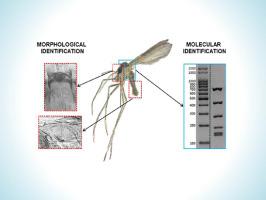Acta Tropica ( IF 2.1 ) Pub Date : 2020-06-27 , DOI: 10.1016/j.actatropica.2020.105609 María Cristina Almazán 1 , Griselda Noemí Copa 1 , Juan José Lauthier 2 , José Fernando Gil 3 , Inés López Quiroga 4 , Carlos Lorenzo Hoyos 5 , Melisa Evangelina Díaz Fernández 4 , Julio Rubén Nasser 4 , Masataka Korenaga 6 , Jorge Diego Marco 7 , Paola Andrea Barroso 7

|
Leishmaniases are vector-borne diseases that in the Americas are distributed from southern United States to northern Argentina. The vectors for this disease are small dipterans known as sand flies that are usually identified morphologically by observing structures with taxonomic value; but it is time-consuming, laborious, and requires entomological expertise. Then, this work was aimed at identifying sand flies with molecular techniques, using the morphological identification as a reference technique, in an endemic area of American Tegumentary Leishmaniasis (ATL) located in northern Argentina. For this, sand flies were caught at two patches of vegetation adjacent to rural areas in Orán department, Salta Province. Females were dissected with sterile needles; the head and last abdominal segments were analyzed for morphological identification. The remaining thorax and abdominal segments were used to extract DNA, which was amplified by PCR of the small subunit (SSU), 18S rRNA gene. PCR products were digested with CviQI and DdeI enzymes to identify sand fly species by Restriction Fragment Length Polymorphism (RFLP) analysis. Thus, the restriction pattern of each caught species was defined according to morphological identification. A total of 1501 females, belonging to four sand fly species, were captured. Nyssomyia neivai (1347/1501) was the most abundant species, followed by Migonemyia migonei (90/1501). From the total, 801 females were morphologically and molecularly identified, while 700 females were characterized only molecularly. For those females analyzed by both methods, there was total coincidence in the achieved result. Besides, the 5% (38/801) of females that could not be determined morphologically due to inadequate mounting were molecularly identified. All the females characterized just by PCR-RFLP, were successfully identified. Our results indicate that the explored method is capable of identifying the sand fly species that circulate in an ATL endemic area. Since this method is based on the analysis of markedly different patterns, the identification process might be more easily reproduced, as the bias introduced by the technician's lack of experience is removed.
中文翻译:

沙蝇分型:一种简单且受到形态学支持的方法,基于阿根廷利什曼病病流行地区18S rRNA基因的多态性。
利什曼原虫病是媒介传播的疾病,在美洲从美国南部分布到阿根廷北部。该病的媒介是小二倍体,称为沙蝇,通常通过观察具有分类学价值的结构在形态上进行鉴定。但是这很费时,费力,并且需要昆虫学专业知识。然后,这项工作旨在通过分子技术,以形态学鉴定为参考技术,在位于阿根廷北部的美国虎耳草利什曼病(ATL)流行地区鉴定沙蝇。为此,在萨尔塔省奥兰省农村地区附近的两个植被丛中捕获了沙蝇。用无菌针头解剖雌性。分析头部和最后一个腹部节段的形态学鉴定。其余的胸部和腹部段用于提取DNA,并通过小亚基(SSU)18S rRNA基因的PCR进行扩增。PCR产物用CviQI和DdeI酶消化,通过限制性片段长度多态性(RFLP)分析鉴定沙蝇种。因此,根据形态鉴定确定了每个捕获物种的限制模式。总共捕获了1501只雌性,属于四种沙蝇种。Neyssomyia neivai(1347/1501)是最丰富的物种,其次是Migonemyia migonei(90/1501)。从总数上,在形态和分子上鉴定出801名女性,而仅在分子上鉴定出700名女性。对于通过两种方法分析的女性,获得的结果完全一致。此外,通过分子鉴定,确定了由于安装不充分而无法通过形态学确定的5%(38/801)雌性。成功鉴定出仅以PCR-RFLP为特征的所有雌性。我们的结果表明,探索的方法能够识别在ATL流行区域中传播的沙蝇物种。由于此方法基于对明显不同模式的分析,因此可以消除识别过程,因为消除了技术人员缺乏经验所带来的偏见。









































 京公网安备 11010802027423号
京公网安备 11010802027423号